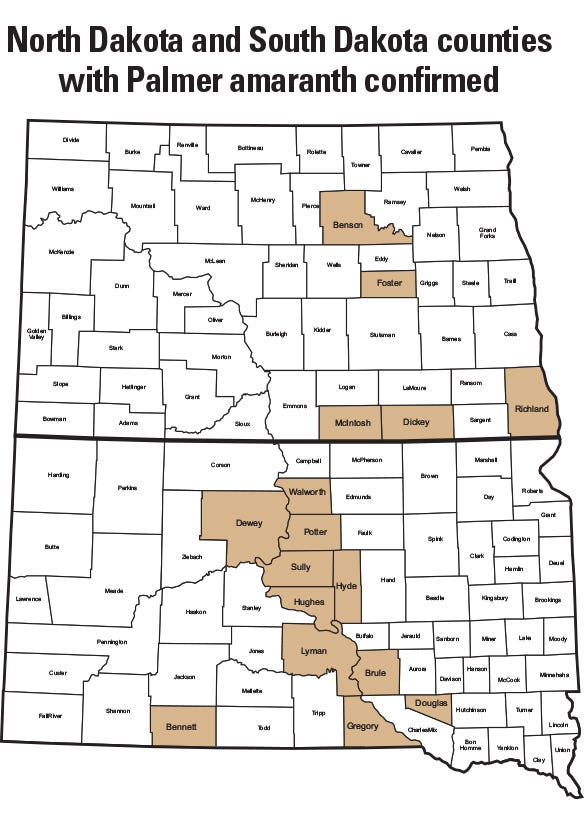November 21, 2018

When planning your 2019 crop rotation and herbicide program, take into account that Palmer amaranth has been confirmed in 11 South Dakota and five North Dakota counties.
In South Dakota, Palmer has been found Bennett, Brule, Dewey, Douglas, Gregory, Hughes, Hyde, Lyman, Potter, Sully and Walworth counties. Palmer was generally limited to one spot in the county, says Paul O. Johnson, South Dakota State University Extension weed specialist.
In North Dakota, Palmer amaranth has been confirmed in five counties — McIntosh, Benson, Dickey, Foster and Richland.
Seed sources
Palmer amaranth found in North Dakota this year came from seed carried into the states through several methods — the purchase of used farm equipment, migratory birds, custom combines, railroad cars and feedstuffs, says Thomas Peters, North Dakota State University Extension sugarbeet agronomist.
The Palmer plants apparently germinated later in the year. They were pulled and destroyed before they went to seed. But if any Palmer plants escaped detection — and some likely did — their seed has probably been spread by wind, water, combines, trucks and wildlife.
Next year, Palmer may germinate and produce viable seed earlier.
With confirmation that Palmer amaranth’s in the Dakota, "you really have to farm as if you do have the weed in your fields," says Duane Rathmann, BASF technical service representative. BASF makes several herbicides that can be used to help control Palmer.

"Attacking it in year one is much more successful than in year two or three," Rathmann says. "If you would miss it for a year or two and allow for the weed to produce seed in your field, you will have a much larger problem."
What to do
Key preventative measures include:
• Rotating crops. "Small grains provide several options of products and chemistries that work on palmer," Johnson says. "Palmer is still a pigweed, so most products that kill pigweed also will control palmer." Corn is another good crop with several control options. Sorghum and soybeans can also be used, but options are more limited in them."
Sunflower is the crop with the most concern as there are no post emergence options, Johnson says.
"We would recommend hand roguing to take out escapes in the sunflower field, if the Palmer is in a small area of the field." He says. "We also recommend hand roguing with any crop. Also, we recommend to harvest the infected area last and then do a very good clean out of the combine in the affected area so as not to move the seed around."
• Planning to overlap your weed control with pre- and post-products that are strong on Palmer. You might even want to consider tank mixing another soil applied produce with a long-residual in with your post emergence herbicide.
"Palmer and waterhemp are very similar in control so think of it as a bad waterhemp and how is it best controlled," Johnson says. Palmer has the ability to germinate all summer long just like waterhemp. Palmer can have varying amounts of resistance and it is hard to know on any field how much resistance the plants have.
• Avoiding herbicides that Palmer may be resistant to. "I would plan that they may will be Su- and glyphosate resistant, for sure. Other possibilities are Post PPO, Trazine and Bleacher (HPPD) resistant," Johnson says. "We have not seen or heard of any growth regulator resistance. Most of [growth regulator] herbicides control it very easily."
3 herbicide programs
Rathmann provided the following examples of products that can be used to control Palmer amaranth in corn, soybeans, wheat and sugarbeets:
• For soybeans, residual herbicides with modes of action including groups 14 and 15. BASF offers several, including Outlook herbicide, Zidua PRO herbicide, and Zidua herbicide. Products containing Zidua are the strongest off all group 15 herbicides on waterhemp. Group 14 herbicides such as Verdict herbicide, Sharpen herbicide or Zidua PRO herbicide, which contains a group 14, would be good choices.
• For emerged weeds, post applied Liberty herbicide in Liberty Link soybeans, which is a group 10, or group 4 Engenia herbicide in dicamba-tolerant soybeans, will be effective on four-inch-or-less plants. But a residual group 15 product should also be tank mixed with the post herbicide to achieve a continuous layer of protection, as it is better to keep Palmer amaranth from emerging than trying to control it once it is out of ground.
• For corn, start with a soil-applied residual group 15 herbicide. BASF offers Outlook herbicide, Verdict herbicide, or Zidua herbicide. A soil applied group 14, such as Sharpen or Verdict, will offer good residual control. For emerged Palmer amaranth, growth regulator group 4 herbicides such as Clarity or Status herbicides, as well as group 27 products including Armezon herbicide and Armezon PRO herbicide, can also be effective.
• For small grain and sugarbeet, the same rules apply; use a soil applied residual product that is effective on Palmer amaranth followed by a post product tank mixed with a residual.
You May Also Like




